In the moonlit circle above Teotihuacán, a mother confronts her lineage of pain and finds renewal in community and ceremony.
Editor’s Note
This is the third and final part of our Moon Dance series, published as the women of the Danza de la Luna prepare for their fourth and final night of ceremony at Cerro Gordo, Teotihuacán. In this piece, Esperanza Project founder Tracy L. Barnett steps out from behind the notebook to share her own first-person journey into the circle — a story of prayer, song, healing, and the enduring legacy of Abuela Ana Lucía Chinas and all the women of the Danza de la Luna.
Leerlo en español AQUÍ
Oct. 18, 2024 — Waxing almost-full moon in Taurus — Matlacti uan yei Cipactli (8 Crocodile in the Aztec calendar)
Dear ones,
I was blessed recently to attend the Moon Dance led by the grandmother of our Mexica dance circle, Abuela Ana Lucía. The location: halfway up Cerro Gordo, an hour north of Mexico City, at a ceremonial site overlooking the Pyramids of the Sun and the Moon.
“It will change you,” Abuela warned me when I told her I intended to join as a support person.
She was right.
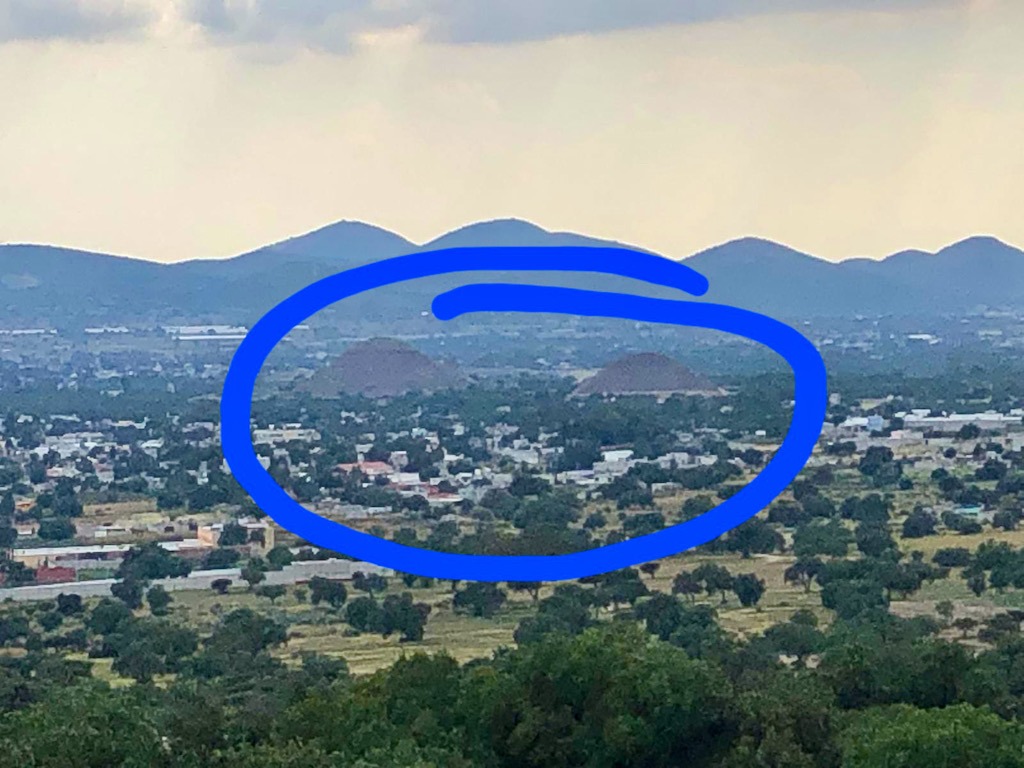
Arrival at Cerro Gordo
SAN MARTÍN DE LOS PIRÁMIDES, Estado de México —
An ancient taxista dropped me at the gate where his equally ancient car had labored to bring me. I hoisted my heavy backpack, climbed the gate, and paused to listen — only birds answered. Following my GPS toward the point Abuela had sent hours earlier, I trudged up the rocky path until a wave of laughter reached me on the breeze.
Rounding a bend, I saw a bright-eyed boy surrounded by a cluster of little girls. His face lit up when he saw me. “Tracy!” he exclaimed. “I’m David, Fatima’s son.” It wasn’t until later I realized Fatima was another name for Yumiko, the beautiful Japanese-Mexican woman I’d danced beside for years without knowing her full story.
“Where are the others?” I asked.
“Sleeping,” he said, gesturing toward the tents. Then, “Ven — come.”
He guided me to the Kalihuey, the long, low structure named for the Wixárika temple, where he told me to leave my things, then on to the kitchen. There, Cecilia and Ana — the women on kitchen duty — were finishing breakfast and assured me they didn’t need help just then. So I wandered uphill, searching for a quiet place to write.
The path climbed through grasses crowned with soft white seedheads, past graceful pirúl trees and stately nopales heavy with red fruit. From a flat stone in the shade, I looked out on a pyramid-shaped mountain and the village below.
A child’s voice drifted up the hill: “Estamos en las montañas,” he told his mother as they climbed.
“Sí,” she answered gently. “Mira, es una espina.” Look, there are thorns here.
It was one of many tender moments of motherhood I would witness in the days ahead — blessings, as I had prayed for healing of the mother-daughter wound my daughter and I both carry. I dedicated this danza, this prayer, to her.
It had been a long, sleepless night on the bus, but now, sitting on the friendly basalt, the sounds of birds and the village below, I felt peace wash over me.
I had arrived.
I was home.
The adventure had begun.
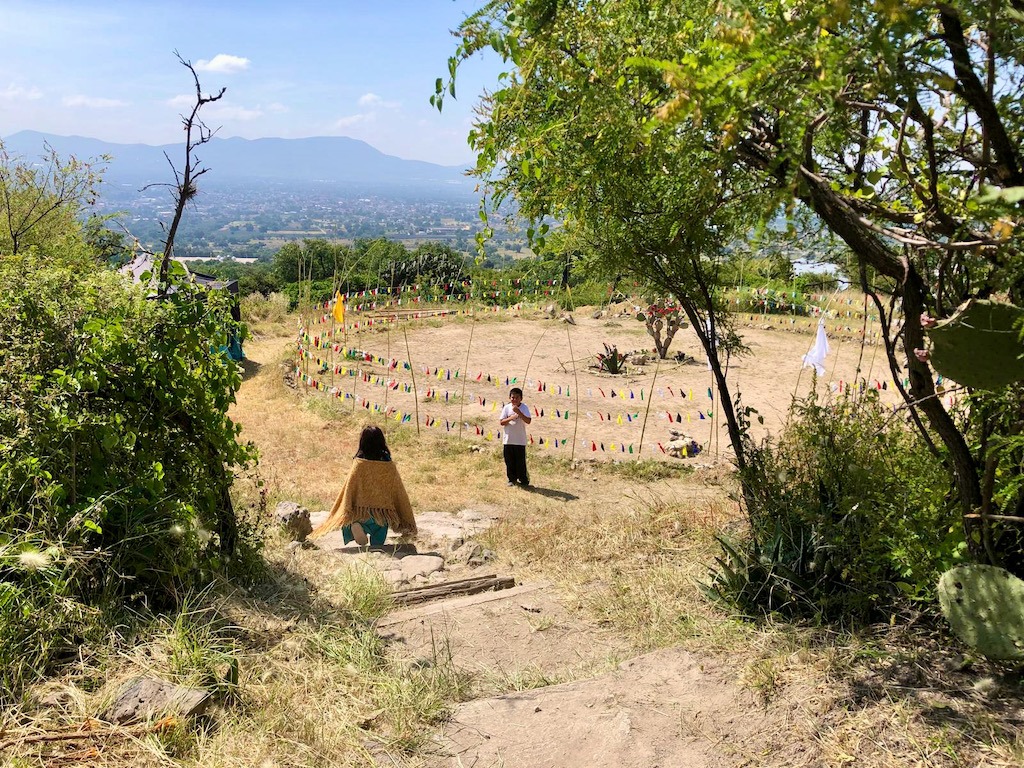
This story concludes The Esperanza Project’s three-part series on the Danza de la Luna at Teotihuacán.
💫 Part 1 — A Conversation with Abuela Ana Lucía
🌕 Part 2 — Four Nights, One Vision: How the Moon Dance Transforms Women at Teotihuacán
🌙 Part 3 — Moon Dance: Living Ancient Mysteries, Healing the Mother Wound
Together, these stories explore a ceremony that has quietly transformed lives for more than three decades, honoring the women who continue to keep its fire alive.
A Day of Preparation, A Night of Fire
Oct. 19 — Waxing Gibbous in Gemini | Matlacti uan Nahui Ehekatl (9 Wind)
It’s hard to find words for what I lived that first day of my first Moon Dance. Amazing, magical, otherworldly—none quite fit. Perhaps it’s enough to say that an entire lifetime seemed to unfold within twenty-four hours on this mountain above the Pyramids of the Sun and the Moon.
The day was spent in preparation for the night. Thankfully, Ángela invited me to nap in her tent—mine hadn’t fit in my pack, and the sleeping area in the Kalihuey was full. I wasn’t sure I could rest in daylight; my body resists it. Yet within minutes I slipped into another realm. I awoke once or twice and tried to reach my phone but couldn’t move. It was a gift, that stillness; I would need the energy for the long nights ahead.
When I woke again, the late-afternoon light painted the camp in gold. I spent time reconnecting with women from my Kalpulli: Maku, an attorney turned healer; Angélica, a poised young professional who astonished everyone with her todo terreno—all-terrain—spirit, hauling wood and pitching tents; and Noemí, who goes by Brenda, the luminous young woman who once sold me my beloved little car Iyari.
I was journaling about Tara, dedicating this danza to her, when Abuela Ana Lucía emerged from the sleeping quarters.
“¡Qué gusto verla aquí!” she exclaimed, greeting me with the firmest embrace I’d ever received from her. Normally reserved and serious, she radiated warmth. With her flowing silver hair and lithe frame, she is ageless—nearly a decade younger than I, yet always and only Abuela, a title she earned early while studying with Tlakaélel, one of the principal voices of Mexicanidad.
“I’m so glad you decided to come,” she said, her eyes bright.
“Al contrario—it’s an honor,” I replied.
She gestured toward my open laptop. “Working?” she asked, knowing how my journalism often keeps me tethered.
“Yes—writing about my daughter,” I told her. “I’ve watched you and your daughter over the years and admire your bond. I also have a good relationship with mine, but to share something as profound as the Danza —that would be truly special.”
She nodded. “It wasn’t always this way,” she said quietly. “I used to make her come to every Danza. Later she moved away and kept her distance. But now, with her return to Guadalajara and her little ones, she’s come back—and it’s beautiful.”
The two of them form a powerful pair: Abuela Ana guides the dance, her daughter Ketzalmetztli leads the cantos, the sacred songs blending Lakota and Nahuatl traditions. Each Monday, Abuela leads us in Danza Mexica in the plaza near my home. Each Wednesday, Ketzal gathers us around the great Lakota-style drum. We each take a baqueta, raise our voices in hymns to Wakan Tanka, to God, to Ometeotl, the duality that is Life itself.
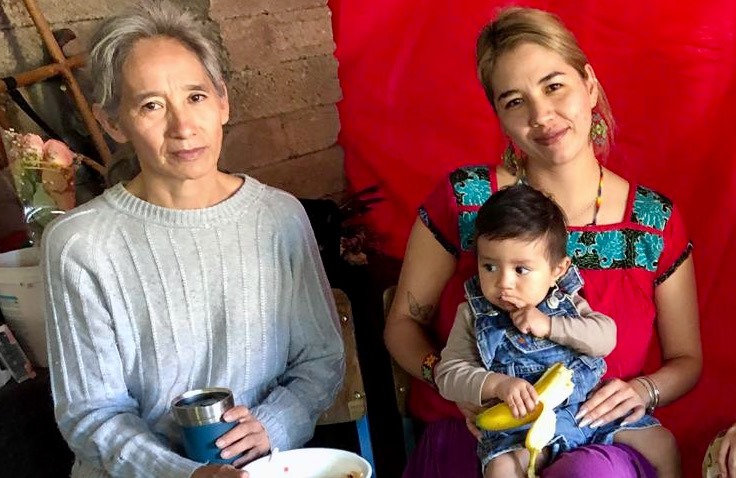
That became my role in the Danza de la Luna. I took my place among the women in the Casa de Cantos, grasped my baqueta, lifted my voice, and became part of the circle.
The Healing Temazcal
Oct. 22 — Waning Moon in Cancer | Matlacti uan Ome Coatl (12 Serpent)
Looking back at the Danza de la Luna feels like gazing into a dream. Fragments float through my mind: the foxtail grasses shimmering silver in the night breeze; the ancient nopal at the circle’s center, its arms draped with long strings of rezos — little packets of tobacco and cloth, each one a prayer for one of the Four Directions. The laughter of children. The murmur of women’s voices as they organized, cooked, and cared for one another. The slow sunset over the pyramids of Teotihuacán, barely visible through the haze, yet unmistakably present.
Each evening, as the sun dropped, the Águilas del Fuego—the Fire Eagles—stoked Abuelo Fuego, heating the volcanic stones that would soon glow red within the temazcal. Then the caracol, the conch shell, called us to form a line outside the low clay dome. My first night I waited for the second round, reserved for the mothers and their children and for us, the apoyos, the support crew.
Inside, Miguel, the leader of the Fire Eagles, tended the stones and invited us to breathe with intention: to draw in the prayers of the heart and exhale fear into the elements—Earth, Fire, Water, Air—so they could be transmuted.
There, in the darkness and the rising steam, I entered the cave of my own heart. I saw the wound I had come to heal: the one between my daughter and me, and the older one between my mother and hers. I wept for the long hours my little girl once waited for me to come home from work, for the loneliness we both endured, for all the ways I fell short of the parent I wished to be. Tears mingled with the vapor; I offered them to the Mother who holds us all.
Miguel’s gentle voice called me back with a prayer, then a song. As we sang, the heaviness lifted. In its place came forgiveness—of myself, of the generations before me. Gratitude flowed in.
When we emerged from the temazcal, dripping and trembling in the cool night, the great huehue drum pulsed in the distance. The women’s voices rose in rhythm: “Hey hey hey, Ometeotl… Tlazocamati, tlazo, tlazocamati.”
Drawn by the sound, I hurried to the Casa de Cantos. Five women sat around the drum, their arms strong, their voices a lifeline to the dancers moving like white shadows in the moonlight. Angélica handed me a baqueta. I joined in—tentative at first, then steady—as the rhythm carried me. The songs flowed through us, a fusion of Lakota, Náhuatl, and Spanish, an ancestral language of praise.
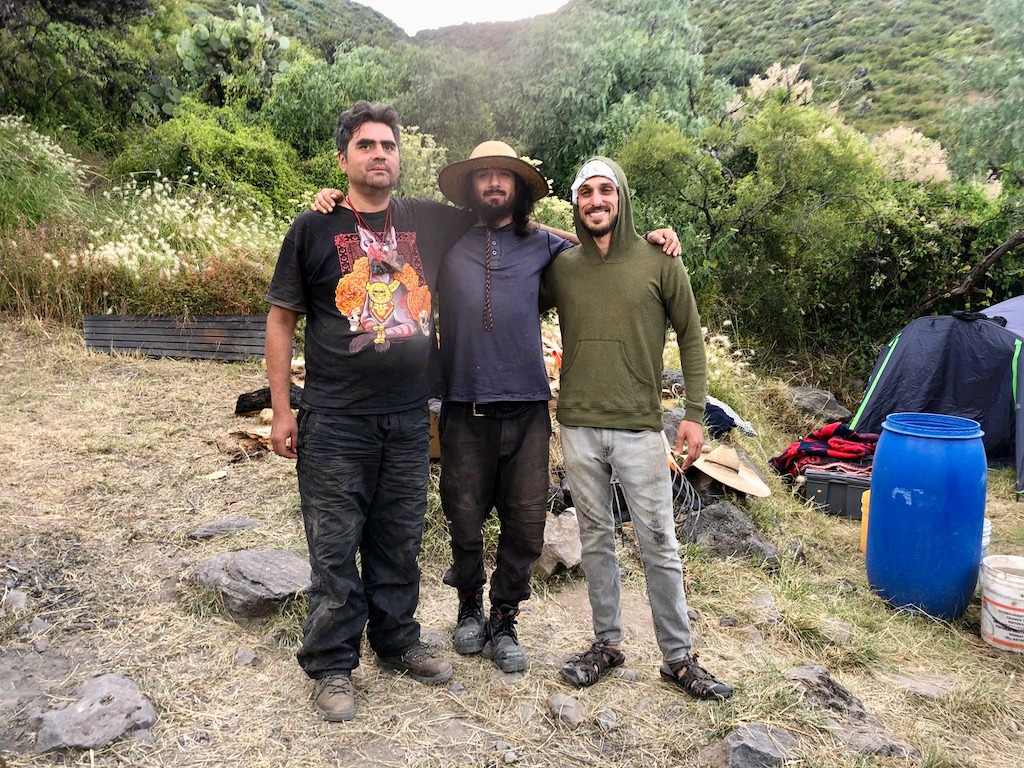
Round after round, hour after hour, we sang and drummed through the night. The dancers never stopped moving; the singers never stopped singing. At times exhaustion blurred the edges of reality, but the rhythm held us, tethering body to spirit, Earth to sky.
Then, as the first round came to an end, Abuela Ana Lucía appeared in the doorway, luminous in the moonlight.
“Vamos a cenar y descansar un poco,” she said gently. “We’ll eat and rest, then begin again.”
Later came the Medicine Round. One by one, we removed our shoes and entered the circle. Abuela approached with a fan of feathers, sweeping lightly through my energy field, followed by others who did the same. I closed my eyes and felt generations of sorrow lifting, carried away on the night wind. Under the waxing moon, I was cleansed.
By the final round, my exhaustion was complete, yet something deeper kept me upright. When the first light touched the horizon, the dancers moved toward the North Gate, spinning once before stepping out of the circle. The moon faded into dawn.
I realized then what Abuela Ana Lucía meant when she said the dance changes you. It does. Not in grand gestures, but in the quiet places inside—where forgiveness becomes prayer, and prayer becomes life.
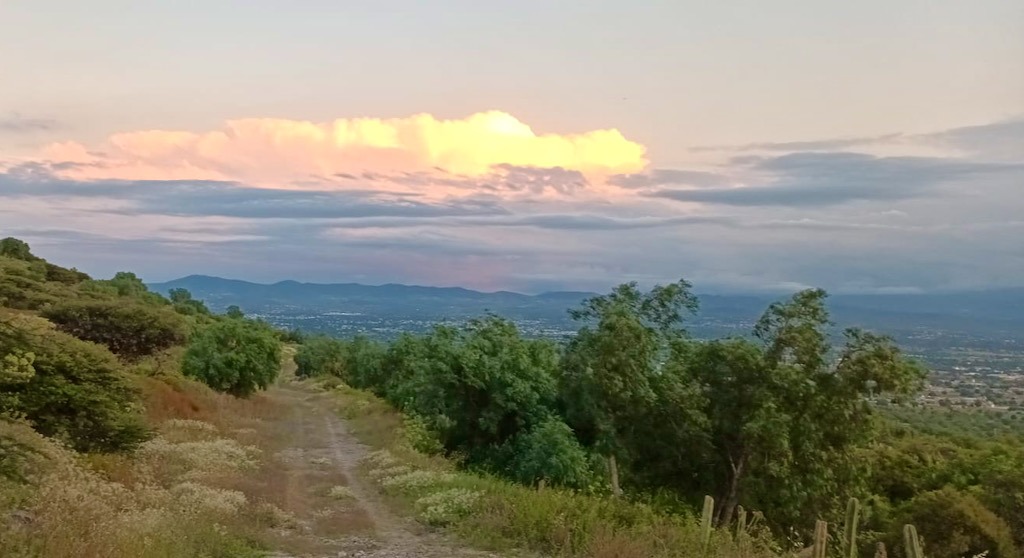
Dawn and Reflection
Oct. 29 — Waning Crescent in Libra | Chicuace Malinalli (Six Vines)
Dawn came softly, pale light spilling over the pyramids below. The rhythm of the huehue slowed, then ceased, leaving only the sound of wind through the nopales and the murmurs of women greeting the morning. The circle opened toward the North Gate, and one by one the dancers stepped out—tired, radiant, transformed.
I sat for a long while watching them. Some embraced, others wept quietly, their faces streaked with sweat and moonlight. The Fire Eagles quenched the last embers of Abuelo Fuego, the smoke rising like a final prayer. Children ran through the clearing, laughter echoing across the slope of Cerro Gordo. The world, for a moment, felt new.
In that stillness, I thought again of my daughter—of the love that binds us across time and distance, imperfect and enduring. I thought of my mother, of her mother, of all the women who carried their wounds in silence. I understood now that my participation in this dance was never only for service, for my community. It was also for me; for us, for the long lineage of women standing behind me and descending from me, seeking wholeness beneath the same moon.
The Danza de la Luna is not something you watch; it is something that enters you. Its rhythm becomes your heartbeat, its smoke your breath, its prayers your own. It teaches not through words but through exhaustion, humility, and the soft strength of community.
When I finally descended the mountain, my body ached and my clothes smelled of smoke and copal. Yet inside, I carried a lightness I had not known before—a quiet certainty that healing had begun.
Even now, months later, I can close my eyes and feel the pulse of the drum, the voices rising in the darkness, the moon sailing above us in her eternal dance. I remember Abuela Ana Lucía’s words: “La danza nos prepara… no se vale subir a la montaña y regresar igual.”
No, I have not come back the same.
This offering, dedicated to my daughter Tara and to all daughters and mothers, is my prayer of gratitude—to Abuela Luna, to the women who keep her fire alive, and to the generations still to come who will dance her song anew.
In another life, Tracy Barnett is Macuilxochitl, or Five Flower, and a Water Carrier. She has danced for 8 years with the Kapulli Kuetzpalkalli dance circle in Guadalajara under the guidance of Abuela Ana Lucia Chinas.
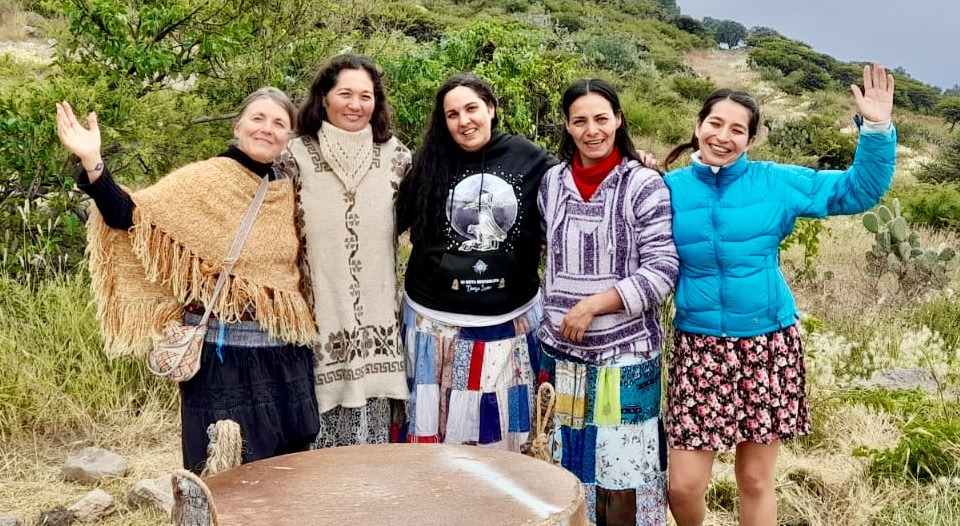
Oh, I love this so much! Such a colorful and heartfelt story! Thank you Tracy.
Thank you, Toni! Your comments really mean a lot to me.
This is so beautiful. Thank you for sharing.
Thank you so much for living it with me, in a way… because that’s what reading one’s writing really does! Wonderful to share with you, sister.
I felt almost as if I was able to go there with you. ❤️